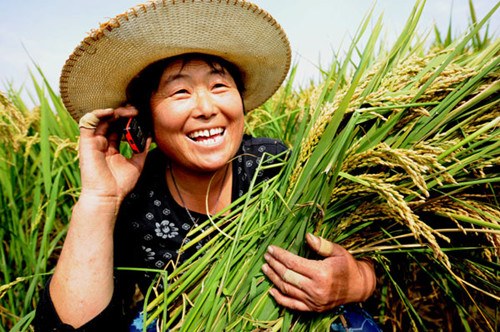
A farmer in Zhumadian, Henan province, talks to her son on a cell phone about October's good rice harvest. ZHAO XUEFENG / FOR CHINA DAILY
China increased its grain imports this year, but thanks to consecutive years of bumper crops the country will continue to be able to largely feed itself, a senior agricultural official said on Tuesday.
China's imports of its three main food staples — rice, wheat and corn — reached 10.09 million metric tons in the first 10 months of this year, an increase of 9.29 million tons compared with the same period last year, said Bi Meijia, chief economist of the Ministry of Agriculture. The total imports of the three main grain crops were 3.57 million tons in 2011.
"China did ramp up its grain imports in recent years, mainly as a result of the increasing domestic need for grains for fodder and industrial use, and the rising demand for more grain varieties," he said at a news conference organized by the State Council Information Office.
The strong surge in imports of the three staple crops has triggered widespread concern about the country's long-asserted goal of maintaining its food security by domestically supplying at least 95 percent of the grains that it consumes.
But both government authorities and analysts said there is no shortage of grain in China.
"The total import volume of rice, wheat and corn now accounts only for about 2 percent of the country's production output. China will surely continue to be largely self-sufficient in grain production," Bi said.
Analysts believed so much was imported mainly because of the big price differences between domestic and relatively cheaper international markets.
They said this price discrepancy was created by the government's minimum purchase price, which shored up domestic grain prices while they declined on the global market due to weak demand as a result of the sluggish economic recovery.
"The government should allow the purchase price some flexibility to fluctuate with international market prices," said Ma Wenfeng, a senior analyst at Beijing Orient Agribusiness Consultant, one of the industry's largest specialist consultancies.
Ma also said cheap imports are likely to push down domestic grain prices while greatly adding to the country's stockpiles, which is likely to lead to a waste of grain in processing and storage.
Also, the import volume of soybeans from this January to October was 48.34 million tons in China, a 16.6 percent year-on-year increase during the first 10 months of this year, Customs statistics showed.
The total import of soybeans is expected to reach more than 60 million tons in 2012 because of favorable prices in the international market, Bi said.
But China will certainly satisfy more than 40 percent of its demand for oil crops by itself, he said.
China recorded a grain output of more than 589 million tons in 2012. It was the ninth consecutive year of increased grain harvests, according to the ministry.
From 2004 to 2012, the total grain output rose by more than 158 million tons, of which nearly 60 percent came from the improved yield on corn, it said.
Also, about 88 percent of the increase in grain output over those nine years came from the country's 13 major grain-producing regions. For instance, an increase in grain output in Northeast China, where industrialized agriculture produces high yields, accounted for nearly 40 percent of the country's increase in grain output during that period, according to the ministry.
The increase in grain output relying on the expansion of arable land is quite limited in the future because of the country's rapid urbanization, Bi said.
"So more advanced agricultural technology input is needed to improve grain yields per unit," he said.

Copyright ©1999-2011 Chinanews.com. All rights reserved.
Reproduction in whole or in part without permission is prohibited.